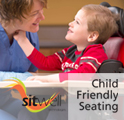Your child’s feet are probably pretty low on that list. But if you notice flat feet, that’s not something to ignore.
What Are Flat Feet?
As the name suggests, flat feet (also called pronation, flexible flat foot, and pes planus) are pretty easy to spot. Normally, feet have an arch. But for kids with flat feet, most or all of their foot touches the floor.
Although this seems like a foot problem, it actually begin in the heel. Your child’s calcaneus (heel bone) rotates inward. This causes the foot to collapse inside where the arch should be. So instead of body weight being distributed evenly, your child is walking on the inside part of the foot.
There’s a simple way to check. Have your little one stand barefoot, facing away from you. Take a picture from directly behind. If you can see a pinky toe and big toe, his or her feet are likely fine. If you can see a pinky toe, ring toe, but not big toe, your child is likely pronating.
Although untreated flat feet can cause problems, they’re not always a cause for alarm. As toddlers learn to stand and walk, flat feet are common. Your child is still developing. But if he or she has been walking for more than six months and you still see flat feet, keep an eye on them. What you want to look for are signs of what’s called excessive pronation:
• Pain
• Fatigue
• Clumsiness
• Development delays
What Causes Flat Feet In Children?
There’s more than one possible reason. And a big indicator comes from where he or she falls on the muscle tone spectrum:
Low Muscle Tone
For kids with low tone, the culprit is ligament laxity. This simply means the ligaments (connective tissue) are too stretchy. This allows movement beyond the normal range of motion. The heel bone rotates in, which collapses the arch.
High Muscle Tone
For kids with high tone, the Achilles tendon is too short, which pulls the foot inward.
What Problems Do Flat Feet Cause?
Although it may seem like just a foot problem, flat feet can cause a chain reaction up your child’s body that forces ankles, knees, and hips out of proper alignment. Other potential problems include:
• Joint pain
• Muscle exhaustion/weakness
• Improper walking pattern
• Possible toe walking
• Poor foot development
Flat feet in children can be especially problematic for those under seven years old. If your little one hasn’t reached that birthday yet, there’s a significant amount of cartilage in his or her feet. Similar to the soft spot on their head, it will eventually harden and become bone. But that means if your child isn’t walking correctly while those bones development, it can impact their shape and growth.
How Do You Fix Flat Feet In Children?
Activity modifications
The child needs to temporarily decrease activities that bring pain as well as avoid prolonged walking or standing.
Orthotic devices
The foot and ankle surgeon can provide custom orthotic devices that fit inside the shoe to support the structure of the foot and improve function.
Physical therapy
Stretching exercises, supervised by the foot and ankle surgeon or a physical therapist, provide relief in some cases of flatfoot.
Medications
Nonsteroidal anti-inflammatory drugs (NSAIDs), such as ibuprofen, may be recommended to help reduce pain and inflammation.
Shoe modifications. The foot and ankle surgeon will advise you on footwear characteristics that are important for the child with flatfoot.
What Should You Do?
Many people, doctors included, treat flat feet with a roll of the eyes. It’s not seen as a big deal. This often leads to a “wait and see” recommendation.
But trust your instincts. As a parent, you are your child’s greatest advocate. If you see developmental delays or if something just feels off, get the help your child needs.
Ask your paediatrician for a referral to a pediatric orthotist near you.






























